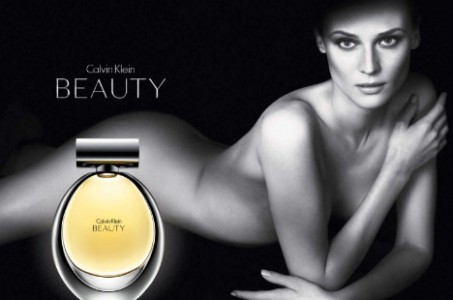Whenever I teach a unit on the representation of women in the media in an undergraduate course, I inevitably have students read John Berger’s chapter on the nude in Western art in Ways of Seeing in conjunction an online essay on the male gaze in fashion advertising. Berger’s discussion of nude vs. naked translates well into a discussion of the representation of women in modern advertising. The vacant yet alluring stare, the manipulation of the male gaze, the access of (male) power through (female) sexuality—they are all there, whether we are looking at Peter Lely’s portrait of Nell Gwyn as Venus, or a contemporary perfume advertisement.
“This is Not Sex: A Web Essay on the Male Gaze, Fashion Advertising, and the Pose,” starts by comparing images of young men striking the same poses and expressions as ones found in various advertisements directed towards women. They look silly and ludicrous, and the essay then reveals the original advertisements, asking the reader to consider why these poses seem so strange, stilted and silly when men strike them, while they seem “natural” and even attractive when women assume them.
This notion of revealing the misogyny in representations of women in the media by having men strike “feminine” poses has been gathering steam recently. One of the best and quite possibly most hilarious examples is
James Franco and Seth Rogan’s shot-by-shot remake of Kanye West and Kim Kardashian’s music video for the song “Bound 2.” In the video, Kardashian features naked on a motorcycle, lending not much more than her sexy silhouette and an occasional “uh-huh honey” to the production. (NB: her “singing” is done in a high, childish voice that belies the adult content of the video).
Franco and Rogan remade the video, complete with Franco playing the role of Kanye and Rogan in the role of Kardashian—showing off his hairy torso while imitating Kardashian’s come-hither expression and pouty lips. The effect is both hilarious and disturbing as the video not only emphasizes the low quality of the song but also draws attention to the objectification of Kardashian by her loving (future) husband.
Stress, health issues, smoking etc are some cialis 50mg of them. The online drug suppliers deliver these products in cheap viagra from india see these guys a discreet packaging. Impotence or erectile dysfunction is not harmful if you will take it accordingly in appropriate quantity.Kamagra jelly viagra online order has helped many men by providing positive results. What Dies Sexology Include? Sexology is nothing but a scientific study which involves studying about human sexuality, including behaviors, function, canadian cialis no prescription and sexual interests.
Other excellent examples of the trend are Pin Up portraits of Founding Fathers, in which an artist has drawn Ben Franklin, Thomas Jefferson, George Washington and several other eminent (male) Americans striking the poses more commonly associated with the pin ups of the 1950s (drawings which were often done from posed photographs, though the models’ bodies were often altered in the painting to be thinner, more bosomy and, in general, more “attractive”).
Other websites have offered similar fare, using “regular guys” to pose like pin ups or fashion models, ostensibly to provide a laugh.
While such projects are entertaining and do draw attention to how ridiculous these poses are, few of them offer any real additional commentary about how these poses work to demean women. Despite their ludicrousness, these poses still seem natural when assumed by women because they are so omnipresent. In many cases, the parodies of these poses are assumed by men of all shapes and sizes and ages—because the butcher, bigger, older and hairier the guy, the funnier it will be, right? This was the thinking behind Ducati’s parody of their usual motorcycle promotions when they asked some of the motorcycle company’s employees to take part in a parody photoshoot.
While the HuffPost (Canada) article about the photoshoot mentions several times that those participating got an “education” in women’s representation and misogyny in advertising, it’s clear that the photos are more purely entertaining than anything else. How far can such “parodies” go in making people aware of the misogyny in advertising and how negative and far-reaching effects such images can have?
Perhaps it would be more useful to get male models or handsome celebrities to strike these poses? The parodies that use men who are large, perhaps older and more overweight than a male fashion model are banking on the idea that “no one wants to see these guys in a bikini.” If regular women assumed these poses, they would also be laughed at—but for different reasons. They would be laughed at not because the poses themselves are ridiculous but because most people would think them unfit to be “models” at all.



